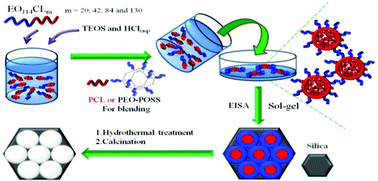In this study we used evaporation-induced self-assembly (EISA) as a facile approach for the synthesis, with amphiphilic poly(ethylene oxide-b-ε-caprolactone) (PEO-b-PCL) diblock copolymers as templates, of a family of mesoporous silicas with large, tunable pore sizes. Transmission electron microscopy (TEM), small-angle X-ray scattering (SAXS), and N2 adsorption–desorption isotherms revealed that the morphology transformed and the pore sizes of the mesoporous silica expanded upon increasing the PCL-to-PEO weight ratio in the templating PEO-b-PCL diblock copolymers. We also employed four kinds of homopolymers—two linear poly(ε-caprolactone)s [PCL20 (Mn = 2100) and PCL408 (Mn = 42 500)], a star poly(ethylene oxide)-functionalized silsesquioxane [PEO13–POSS (Mn = 5776)], and a linear poly(ethylene oxide) [PEO22 (Mn = 1000)]—as additives during the fabrication of these mesoporous silicas. Pore expansion and a unique mesophase transformation occurred when using PCL20 and PEO–POSS as the additive, respectively. Notably, we obtained highly ordered body-centered cubic (space group Im![[3 with combining macron]](https://www.rsc.org/images/entities/char_0033_0304.gif) m) mesoporous silicas with large cage-like pores of 10.1 and 22.6 nm when using EO114CL20 and EO114CL20/PEO–POSS, respectively, as templates for the EISA process.
m) mesoporous silicas with large cage-like pores of 10.1 and 22.6 nm when using EO114CL20 and EO114CL20/PEO–POSS, respectively, as templates for the EISA process.

You have access to this article
 Please wait while we load your content...
Something went wrong. Try again?
Please wait while we load your content...
Something went wrong. Try again?
![[3 with combining macron]](https://www.rsc.org/images/entities/char_0033_0304.gif) m) mesoporous silicas with large cage-like pores of 10.1 and 22.6 nm when using EO114CL20 and EO114CL20/PEO–POSS, respectively, as templates for the EISA process.
m) mesoporous silicas with large cage-like pores of 10.1 and 22.6 nm when using EO114CL20 and EO114CL20/PEO–POSS, respectively, as templates for the EISA process.

 Please wait while we load your content...
Please wait while we load your content...